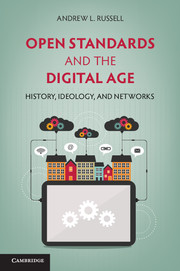Book contents
- Frontmatter
- Dedication
- Contents
- Tables and Figures
- Acknowledgments
- List of acronyms
- 1 Introduction
- 2 Ideological Origins of Open Standards I: Telegraph and Engineering Standards, 1860s–1900s
- 3 Ideological Origins of Open Standards II: American Standards, 1910s–1930s
- 4 Standardization and the Monopoly Bell System, 1880s–1930s
- 5 Critiques of Centralized Control, 1930s–1970s
- 6 International Standards for the Convergence of Computers and Communications, 1960s–1970s
- 7 Open Systems and the Limits of Democratic Design, 1970s–1980s
- 8 The Internet and the Advantages of Autocratic Design, 1970s–1990s
- 9 Conclusion
- Bibliography
- Index
- References
9 - Conclusion
Open Standards and an Open World
Published online by Cambridge University Press: 05 June 2014
- Frontmatter
- Dedication
- Contents
- Tables and Figures
- Acknowledgments
- List of acronyms
- 1 Introduction
- 2 Ideological Origins of Open Standards I: Telegraph and Engineering Standards, 1860s–1900s
- 3 Ideological Origins of Open Standards II: American Standards, 1910s–1930s
- 4 Standardization and the Monopoly Bell System, 1880s–1930s
- 5 Critiques of Centralized Control, 1930s–1970s
- 6 International Standards for the Convergence of Computers and Communications, 1960s–1970s
- 7 Open Systems and the Limits of Democratic Design, 1970s–1980s
- 8 The Internet and the Advantages of Autocratic Design, 1970s–1990s
- 9 Conclusion
- Bibliography
- Index
- References
Summary
By the mid-1990s, the Internet’s advocates had learned to cast Internet history in a most flattering light. They downplayed its autocratic and closed world origins, belittled the work undertaken by their competitors in Open Systems Interconnection (OSI), and reimagined the Internet as an open system. In their revisionist hands, the Internet standards process became a novel form of distributed control and participatory democracy that emerged organically from the interactions of Internet engineers. Internet users, dazzled and enchanted by their sublime new toy, searched for secrets of the Internet’s astonishing success that they could apply in other realms. A chorus of academics and policy makers unwittingly latched on to an origin myth – that the Internet was a meritocracy, the product of “nerds” and “hackers” who collaborated through a decentralized and participatory design process.
The Internet standards process was an especially rich source of inspiration for legal scholars who offered new interpretations of legal philosophy, the process of innovation, and the role of nongovernmental and transnational regulatory regimes in the twenty-first-century global economy. In many cases, the lessons gleaned from the Internet success story flew in the face of accepted scientific and engineering practice – evidence, it would seem, that the Internet’s emergence truly marked a new kind of technology-enabled society. For example, Harvard law professor Jonathan Zittrain generalized from his reading of the Internet’s architectural history to propose a “procrastination principle” built on the assumption that “most problems confronting a network can be solved later or by others.” This principle, Zittrain argued, “suggests waiting for problems to arise before solving them.”
- Type
- Chapter
- Information
- Open Standards and the Digital AgeHistory, Ideology, and Networks, pp. 262 - 280Publisher: Cambridge University PressPrint publication year: 2014



